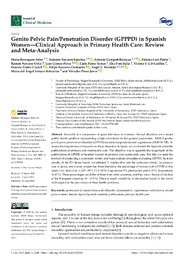Please use this identifier to cite or link to this item:
https://hdl.handle.net/11000/34543Full metadata record
| DC Field | Value | Language |
|---|---|---|
| dc.contributor.author | Berenguer Soler, María | - |
| dc.contributor.author | Navarro-Sánchez, Antonio | - |
| dc.contributor.author | Compañ Rosique, Antonio F. | - |
| dc.contributor.author | Luri-Prieto, Paloma | - |
| dc.contributor.author | Navarro Ortiz, Ramón | - |
| dc.contributor.author | Gómez-Pérez, Luis | - |
| dc.contributor.author | Pérez Tomás, Carla | - |
| dc.contributor.author | Font Juliá, Elsa | - |
| dc.contributor.author | Gil-Guillén, Vicente F | - |
| dc.contributor.author | CORTÉS CASTELL, ERNESTO | - |
| dc.contributor.author | Navarro-Cremades, Felipe | - |
| dc.contributor.author | Montejo, Ángel L. | - |
| dc.contributor.author | Arroyo Sebastián, María del Ángel | - |
| dc.contributor.author | Pérez-Jover, Virtudes | - |
| dc.contributor.other | Departamentos de la UMH::Patología y Cirugía | es_ES |
| dc.date.accessioned | 2025-01-15T19:55:53Z | - |
| dc.date.available | 2025-01-15T19:55:53Z | - |
| dc.date.created | 2022-04 | - |
| dc.identifier.citation | Journal of Clinical Medicine. 2022 Apr 22;11(9):2340 | es_ES |
| dc.identifier.issn | 2077-0383 | - |
| dc.identifier.uri | https://hdl.handle.net/11000/34543 | - |
| dc.description.abstract | Sexuality is a component of great relevance in humans. Sexual disorders are a major public health problem representing a high prevalence in the general population. DSM-5 genitopelvic pain/penetration disorder (GPPPD) includes dyspareunia and vaginismus (DSM-IV-TR). To assess the importance of research on these disorders in Spain, we evaluated the Spanish scientific publications of primary and community care. The objective was to quantify the magnitude of the publications of GPPPD in Spanish women in primary and community care. For this, we used the method of conducting a systematic review and meta-analysis of studies evaluating GPPPD. As main results, of the 551 items found, we selected 11 studies that met the inclusion criteria. In primary care in Spain, one in nine women has these disorders; the percentage of women with GPPPD in this study (raw data) was 11.23% (95% CI: 0–29%) (vaginismus 5%; penetration pain 8.33%; dyspareunia 16.45%). These percentages can differ of those from other countries, and they are at the top of the data of the European countries (911.9%). There is much variability in the studies found in the world with respect to the prevalence of these health problems. | es_ES |
| dc.format | application/pdf | es_ES |
| dc.format.extent | 14 | es_ES |
| dc.language.iso | eng | es_ES |
| dc.publisher | MDPI | es_ES |
| dc.rights | info:eu-repo/semantics/openAccess | es_ES |
| dc.rights.uri | http://creativecommons.org/licenses/by-nc-nd/4.0/ | * |
| dc.subject | Genito-pelvic | es_ES |
| dc.subject | Penetration pain disorder | es_ES |
| dc.subject | Dyspareunia | es_ES |
| dc.subject | Vaginismus | es_ES |
| dc.subject | Vulvodynia | es_ES |
| dc.subject | Sexual pain | es_ES |
| dc.subject | Women | es_ES |
| dc.subject | Female | es_ES |
| dc.subject | Spain | es_ES |
| dc.subject | Spanish scientific publications | es_ES |
| dc.subject | Primary health care | es_ES |
| dc.title | Genito Pelvic Pain/Penetration Disorder (GPPPD) in Spanish Women—Clinical Approach in Primary Health Care: Review and Meta-Analysis | es_ES |
| dc.type | info:eu-repo/semantics/article | es_ES |
| dc.relation.publisherversion | 10.3390/jcm11092340 | es_ES |

View/Open:
Genito Pelvic Pain-Penetration Disorder (GPPPD) in Spanish Women-Clinical Approach in Primary health care. Review and Meta-Analysis.pdf
857,51 kB
Adobe PDF
Share:
.png)
